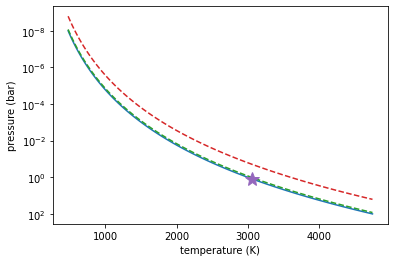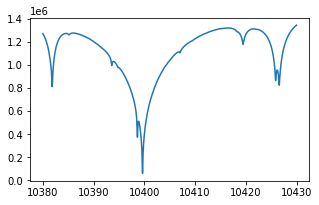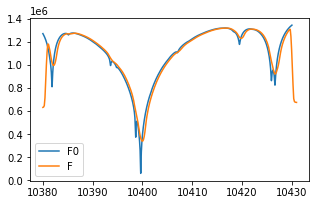Forward modeling of the emission spectrum using VALD3¶
Tako Ishikawa, Hajime Kawahara
created: : 2021/07/20, last update: 2022/10/22
This example provides how to use VALD3 for forward modeling of the emission spectrum. Currenty, we use exojax.spec.moldb as API for VALD3 because we have not implemented the VALD3 API in radis.api yet. Someday, we (or someone who is reading this document.) would include the VALD3 API in radis.api!
from exojax.utils.grids import wavenumber_grid
from exojax.spec.rtransfer import pressure_layer
from exojax.spec import moldb, molinfo, contdb
from exojax.spec import atomll
from exojax.spec.exomol import gamma_exomol
from exojax.spec import SijT, doppler_sigma
from exojax.spec import planck
import matplotlib.pyplot as plt
import jax.numpy as jnp
from jax import vmap, jit
import numpy as np
T-P profile¶
#Assume ATMOSPHERE
NP=100
T0=3000. #10000. #3000. #1295.0 #K
Parr, dParr, k=pressure_layer(NP=NP)
H_He_HH_VMR = [0.0, 0.16, 0.84] #typical quasi-"solar-fraction"
Tarr = T0*(Parr)**0.1
PH = Parr* H_He_HH_VMR[0]
PHe = Parr* H_He_HH_VMR[1]
PHH = Parr* H_He_HH_VMR[2]
fig=plt.figure(figsize=(6,4))
plt.plot(Tarr,Parr)
plt.plot(Tarr, PH, '--'); plt.plot(Tarr, PHH, '--'); plt.plot(Tarr, PHe, '--')
plt.plot(Tarr[80],Parr[80], marker='*', markersize=15)
plt.yscale("log")
plt.xlabel("temperature (K)")
plt.ylabel("pressure (bar)")
plt.gca().invert_yaxis()
plt.show()

Wavenumber¶
#We set a wavenumber grid using wavenumber_grid.
nus,wav,res = wavenumber_grid(10380, 10430, 4500, unit="AA")
xsmode assumes ESLOG in wavenumber space: mode=lpf
Load a database of atomic lines from VALD3¶
#Loading a database of a few atomic lines from VALD3 #BU: CO and CIA (H2-H2)...
"""
valdlines: fullpath to the input line list obtained from VALD3 (http://vald.astro.uu.se/):
VALD data access is free but requires registration through the Contact form (http://vald.astro.uu.se/~vald/php/vald.php?docpage=contact.html).
After the registration, you can login and select one of the following modes depending on your purpose: "Extract All", "Extract Stellar", or "Extract Element".
For a example in this notebook, the request form of "Extract All" mode was filled as:
Extract All
Starting wavelength : 10380
Ending wavelength : 10430
Extraction format : Long format
Retrieve data via : FTP
(Hyperfine structure: N/A)
(Require lines to have a known value of : N/A)
Linelist configuration : Default
Unit selection: Energy unit: eV - Medium: vacuum - Wavelength unit: angstrom - VdW syntax: default
Please assign the fullpath of the output file sent by VALD ([user_name_at_VALD].[request_number_at_VALD].gz; "vald2600.gz" in the code below) to the variable "valdlines".
Note that the number of spectral lines that can be extracted in a single request is limited to 1000 in VALD (https://www.astro.uu.se/valdwiki/Restrictions%20on%20extraction%20size).
"""
valdlines = '.database/HiroyukiIshikawa.4214450.gz'
adbFe = moldb.AdbVald(valdlines, nus)
Reading VALD file
Relative partition function¶
#Computing the relative partition function,
qt_284 = vmap(adbFe.QT_interp_284)(Tarr)
qt = np.zeros([len(adbFe.QTmask), len(Tarr)])
for i, mask in enumerate(adbFe.QTmask):
qt[i] = qt_284[:, mask] #e.g., qt_284[:,76] #Fe I
qt = jnp.array(qt)
Pressure and Natural broadenings (Lorentzian width)¶
gammaLMP = jit(vmap(atomll.gamma_vald3,(0,0,0,0,None,None,None,None,None,None,None,None,None,None,None)))\
(Tarr, PH, PHH, PHe, adbFe.ielem, adbFe.iion, \
adbFe.dev_nu_lines, adbFe.elower, adbFe.eupper, adbFe.atomicmass, adbFe.ionE, \
adbFe.gamRad, adbFe.gamSta, adbFe.vdWdamp, 1.0)
Doppler broadening¶
sigmaDM=jit(vmap(doppler_sigma,(None,0,None)))\
(adbFe.nu_lines, Tarr, adbFe.atomicmass)
Line strength¶
SijM=jit(vmap(SijT,(0,None,None,None,0)))\
(Tarr, adbFe.logsij0, adbFe.nu_lines, adbFe.elower, qt.T)
nu matrix¶
from exojax.spec.initspec import init_lpf
numatrix=init_lpf(adbFe.nu_lines,nus)
Compute dtau for each atomic species (or ion) in a SEPARATE array¶
Separate species
def get_unique_list(seq):
seen = []
return [x for x in seq if x not in seen and not seen.append(x)]
uspecies = get_unique_list(jnp.vstack([adbFe.ielem, adbFe.iion]).T.tolist())
Set the stellar/planetary parameters
#Parameters of Objects
Rp = 0.36*10 #R_sun*10 #Rp=0.88 #[R_jup]
Mp = 0.37*1e3 #M_sun*1e3 #Mp=33.2 #[M_jup]
g = 2478.57730044555*Mp/Rp**2
print('logg: '+str(np.log10(g))) #check
logg: 4.849799190511717
Calculate delta tau
#For now, ASSUME all atoms exist as neutral atoms.
#In fact, we can't ignore the effect of molecular formation e.g. TiO (」゜□゜)」
from exojax.spec.lpf import xsmatrix
from exojax.spec.rtransfer import dtauM
from exojax.spec.atomllapi import load_atomicdata
ipccd = load_atomicdata()
ieleml = jnp.array(ipccd['ielem'])
Narr = jnp.array(10**(12 + ipccd['solarA'])) #number density
massarr = jnp.array(ipccd['mass']) #mass of each neutral atom
Nmassarr = Narr * massarr #mass of each neutral species
dtaual = np.zeros([len(uspecies), len(Tarr), len(nus)])
maskl = np.zeros(len(uspecies)).tolist()
for i, sp in enumerate(uspecies):
maskl[i] = (adbFe.ielem==sp[0])\
*(adbFe.iion==sp[1])
#Currently not dealing with ionized species yet... (#tako %\\\\20210814)
if sp[1] > 1:
continue
#Providing numatrix, thermal broadening, gamma, and line strength, we can compute cross section.
xsm = xsmatrix(numatrix[maskl[i]], sigmaDM.T[maskl[i]].T,
gammaLMP.T[maskl[i]].T, SijM.T[maskl[i]].T)
#Computing delta tau for atomic absorption
MMR_X_I = Nmassarr[jnp.where(ieleml == sp[0])[0][0]] / jnp.sum(Nmassarr)
mass_X_I = massarr[jnp.where(ieleml == sp[0])[0][
0]] #MMR and mass of neutral atom X (if all elemental species are neutral)
dtaual[i] = dtauM(dParr, xsm, MMR_X_I * np.ones_like(Tarr), mass_X_I, g)
compute delta tau for CIA
cdbH2H2=contdb.CdbCIA('.database/H2-H2_2011.cia', nus)
from exojax.spec.rtransfer import dtauCIA
mmw=2.33 #mean molecular weight
mmrH2=0.74
molmassH2=molinfo.molmass("H2")
vmrH2=(mmrH2*mmw/molmassH2) #VMR
dtaucH2H2=dtauCIA(nus,Tarr,Parr,dParr,vmrH2,vmrH2,\
mmw,g,cdbH2H2.nucia,cdbH2H2.tcia,cdbH2H2.logac)
H2-H2
Total delta tau¶
dtau = np.sum(dtaual, axis=0) + dtaucH2H2
Plot contribution function¶
from exojax.plot.atmplot import plotcf
plotcf(nus,dtau,Tarr,Parr,dParr)
plt.show()

Radiative transfer¶
from exojax.spec import planck
from exojax.spec.rtransfer import rtrun
sourcef = planck.piBarr(Tarr, nus)
F0=rtrun(dtau, sourcef)
fig=plt.figure(figsize=(5, 3))
plt.plot(wav[::-1],F0)
plt.show()

#Check line species
print(np.unique(adbFe.ielem))
[12 13 14 17 18 20 21 22 24 25 26 27 28 29 32 38 59 64 65 66 70 90]
Rotational & instrumental broadening¶
from exojax.spec import response
from exojax.utils.constants import c #[km/s]
import jax.numpy as jnp
wavd=jnp.linspace(10380, 10450,500) #observational wavelength grid
nusd = 1.e8/wavd[::-1]
RV=10.0 #RV km/s
vsini=20.0 #Vsini km/s
u1=0.0 #limb darkening u1
u2=0.0 #limb darkening u2
R=100000.
beta=c/(2.0*np.sqrt(2.0*np.log(2.0))*R) #IP sigma need check
Frot=response.rigidrot(nus,F0,vsini,u1,u2)
F=response.ipgauss_sampling(nusd,nus,Frot,beta,RV)
fig=plt.figure(figsize=(5, 3))
plt.plot(wav[::-1],F0, label='F0')
plt.plot(wavd[::-1],F, label='F')
plt.legend()
plt.show()
